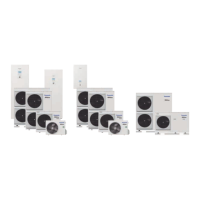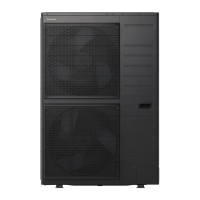
Do you have a question about the Panasonic Aquarea WH-UX12HE5 and is the answer not in the manual?
Critical warnings regarding electrical installation, earthing, and contact with refrigerants.
Guidelines to prevent device damage from incorrect refrigerants, vibrations, or improper installation sites.
Outlines the sequential steps for planning an Aquarea heat pump system installation.
Explains how to determine the design outside temperature and calculate the building's design heat load.
Guides on estimating domestic hot water demand based on comfort levels and recommended tank sizes.
Defines heat pump operating modes and how to determine the bivalence point for cost-effective performance.
Provides a practical example for calculating the total heating capacity needed for a system.
Provides general points for installing bi-bloc systems, including pipe lengths and elevation differences.
Specifies requirements for outdoor unit installation, including minimum distances and foundation.
Illustrates required minimum distances for outdoor units relative to walls and objects.
Details methods for anchoring outdoor units to foundations or floor plates to prevent tipping.
Outlines requirements for the indoor installation room, including volume and ventilation.
Specifies minimum installation distances for indoor units to ensure proper operation.
Covers installation conditions for mono-bloc units, including freezing prevention measures.
Illustrates required minimum distances for mono-bloc units to ensure airflow and proper operation.
Details anchoring requirements for mono-bloc units on foundations or floor plates.
Provides essential safety warnings and guidelines for electrical connections.
Crucial safety warnings and instructions for installers before and during installation.
Details how to connect refrigerant pipes, including requirements for flare fittings and torque.
Step-by-step guide for connecting refrigerant pipes to the indoor unit, emphasizing proper flaring.
Instructions for connecting refrigerant pipes to the outdoor unit, including pipe panel selection and torque.
Provides critical instructions for electrical wiring, including safety and cable connection requirements.
Steps for evacuating the refrigerant circuit and performing a pressure test for bi-bloc systems.
Steps for performing a test run after installation, including checking water pressure and flow rate.
Safety precautions and steps for performing maintenance on the refrigerant circuit, including pump-down.











